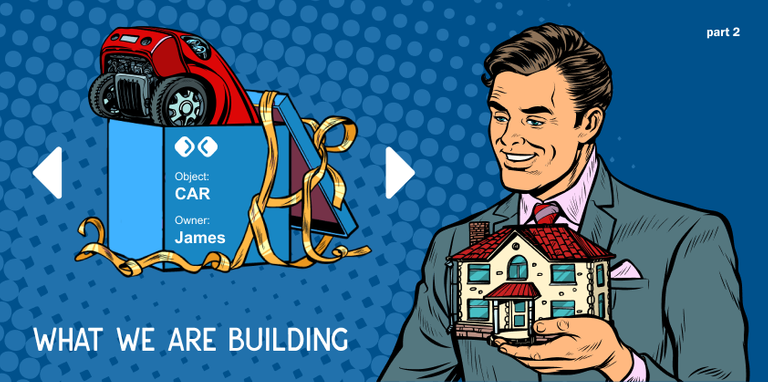
Structure.
Let’s indicate the main functions of the Barter application:
- Wallet;
- Exchanges.
Just two functions?
Yes, it’s true, Barter is used to freely administer your funds and values, and to be able to receive new ones. Let’s consider how large these two points are.
1) Wallet. Created for the convenience of using utility BRTR tokens. We mean for sending them and receiving, as well as for paying barter contracts. Additionally, the wallet will support the storage and use of Bitcoin and Ethereum, and as the platform develops, other coins and tokens. Barter wallet supports ERC-20 tokens (utility tokens), ERC-721 (Collectibles) and ERC-1155 (Lot) tokens.
Thanks to integration with the crypto-fiat exchange, we will provide users with the opportunity to purchase BRTR, BTC and ETH via bank cards. This convenience of buying a cryptocurrency will be available to those users who perform the verification procedure in accordance with the KYC / AML rules.
Collectibles. You might have already heard about decentralized applications (DApp) that use ERC-721 tokens as a unique virtual item. The value of this method is that there is not a single identical token, each has a unique set of characteristics and qualities, and therefore they are valuable. The wide distribution of collectibles was held thanks to the appearance of Crypto Kitties, where each cat is unique. Today there are several marketplaces that give you an opportunity to buy virtual assets of various types of DApp, for example, digital art (Codex Protocol News) and items in games (Cats in CryptoKitties). We will open a marketplace where you can buy a collection of your favorite applications, for example, buy a virtual territory in Decentraland. All this will be convenient with the Barter application.
Users can easily add, buy and manage their collections inside the Barter wallet, place tokens on the internal smartplace (place of trade) to make barter exchange of collections between members of Barter community.
Perhaps the free disposal of cryptocurrencies and their purchase for fiat funds are sufficient functions to fulfill the direct needs of the application as a cryptocurrency wallet.
Each asset owner, whether it is utility tokens, collectibles or stable coins, periodically needs to exchange or sell existing assets, so we offer you to consider the next most important component of the Barter application — exchanges.
2) Exchanges. This is the very section which include the following types of markets:
- Atomic swaps
- Hybrid exchange
- Smartplace
This is a key place that can be called the free market and the engine of the Barter ecosystem, using which we created this project. Let’s talk about this in more detail.
In the blockchain industry, there is a lot of buzz about decentralized finance (DeFi). DeFi today is considered to be the most relevant trend, which has become widely known due to the distribution of decentralized exchanges (DEX) and atomic exchanges, for example, Uniswap, Kyber Network and other services for direct exchange.
We will build our DEX based on the 0x protocol and its extensions, which will provide users with the access to the widest liquidity at a decentralized market. One of the most important 0x updates is the recent approval of the protocol improvement proposal (ZEIP-24) to support ERC-1155 tokens, which we referred as “Lots” even before they were generally accepted for the industry. We enjoy this update a lot.
Why are there three types of exchange? Good question.
We will tell you why we are creating three types of exchanges and why we integrate these types of trading.
Atomic swaps
Exchange tokens directly from your wallet, without using a third party and without contacting ETH to exchange. Atomic swaps are concluded directly between users of the ecosystem.
We plan to integrate one of the largest network liquidity pools, which will open up an opportunity for our users to exchange more than 50 known tokens directly from the wallet.
Hybrid exchange
Today, centralized exchanges remain the best way to trade incompatible coins and tokens, as well as a place to buy cryptocurrency for fiat funds, due to their liquidity and best prices.
Meanwhile, decentralized exchanges (DEX) are excellent trading tools for compatible tokens, which eliminates the necessity to send tokens to the exchange to make a transaction again to return the received assets, and this method requires significantly more time than DEX, which allows you to connect your wallet and exchange token, paying only one gas transaction to make an exchange.
We combine the advantages of both exchange methods to present our users the most convenient place to trade liquid crypto assets. At first, we integrate trading pairs for BRTR, BTC, ETH to stable tokens and fiat currencies.
It is worth adding that decentralized finance and some protocols allow you to earn on lending and securing loans for marginal positions — we will give our users this opportunity. For example, you can earn % on DAI (Stable USD) by providing your ETH as collateral.
Tell me, which pairs are necessary to be added to our exchange? Maybe BNB? Or would you like to buy DGX tokenized gold during the political crisis? ;)
Follow us and comment on articles! In the next story we will talk about smartplace!
Recall that now the project is at the stage of pre-sale of tokens, the proceeds from the sale of which are invested in the development of the Barter project
We accept ETH and BTC to official wallets:
Ethereum — 0x17d3d1da06688bc61592913921414bff09bc570c;
Bitcoin — 17BexJeUQfM1iQqtgoAaqgBLPdRvKZUTR1.
BRTR tokens will be credited to each participant when the wallet is launched.
ewww eth? hahah make it work on steem!!!!
Other wise cool graphics and ideas!